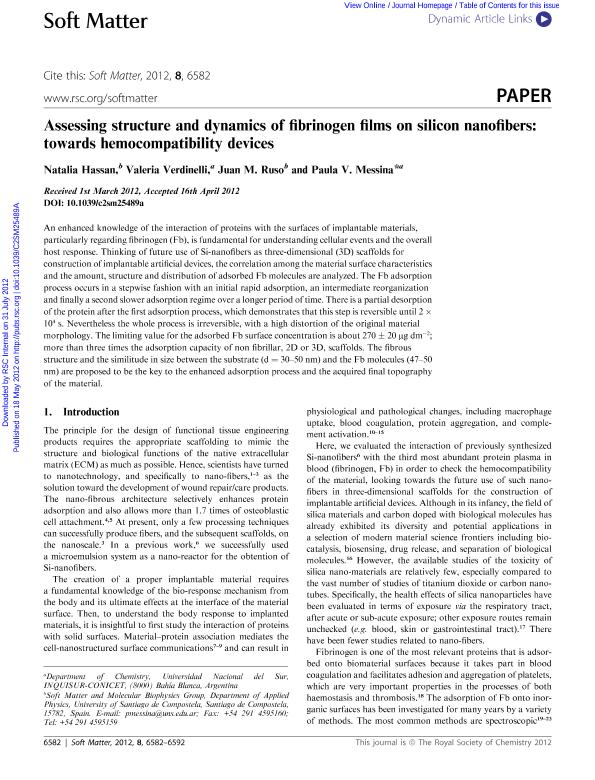Mostrar el registro sencillo del ítem
dc.contributor.author
Hassan, Natalia
dc.contributor.author
Verdinelli, Valeria

dc.contributor.author
Ruso, Juan M.
dc.contributor.author
Messina, Paula Verónica

dc.date.available
2018-10-30T17:45:39Z
dc.date.issued
2012-06
dc.identifier.citation
Hassan, Natalia; Verdinelli, Valeria; Ruso, Juan M.; Messina, Paula Verónica; Assessing structure and dynamics of fibrinogen films on silicon nanofibers: Towards hemocompatibility devices; Royal Society of Chemistry; Soft Matter; 8; 24; 6-2012; 6582-6592
dc.identifier.issn
1744-683X
dc.identifier.uri
http://hdl.handle.net/11336/63306
dc.description.abstract
An enhanced knowledge of the interaction of proteins with the surfaces of implantable materials, particularly regarding fibrinogen (Fb), is fundamental for understanding cellular events and the overall host response. Thinking of future use of Si-nanofibers as three-dimensional (3D) scaffolds for construction of implantable artificial devices, the correlation among the material surface characteristics and the amount, structure and distribution of adsorbed Fb molecules are analyzed. The Fb adsorption process occurs in a stepwise fashion with an initial rapid adsorption, an intermediate reorganization and finally a second slower adsorption regime over a longer period of time. There is a partial desorption of the protein after the first adsorption process, which demonstrates that this step is reversible until 2 × 104 s. Nevertheless the whole process is irreversible, with a high distortion of the original material morphology. The limiting value for the adsorbed Fb surface concentration is about 270 ± 20 μg dm-2; more than three times the adsorption capacity of non fibrillar, 2D or 3D, scaffolds. The fibrous structure and the similitude in size between the substrate (d = 30-50 nm) and the Fb molecules (47-50 nm) are proposed to be the key to the enhanced adsorption process and the acquired final topography of the material.
dc.format
application/pdf
dc.language.iso
eng
dc.publisher
Royal Society of Chemistry

dc.rights
info:eu-repo/semantics/openAccess
dc.rights.uri
https://creativecommons.org/licenses/by-nc-sa/2.5/ar/
dc.subject
Fibrinogen
dc.subject
Adsorption
dc.subject
Sio2
dc.subject.classification
Nano-materiales

dc.subject.classification
Nanotecnología

dc.subject.classification
INGENIERÍAS Y TECNOLOGÍAS

dc.title
Assessing structure and dynamics of fibrinogen films on silicon nanofibers: Towards hemocompatibility devices
dc.type
info:eu-repo/semantics/article
dc.type
info:ar-repo/semantics/artículo
dc.type
info:eu-repo/semantics/publishedVersion
dc.date.updated
2018-10-12T14:45:33Z
dc.journal.volume
8
dc.journal.number
24
dc.journal.pagination
6582-6592
dc.journal.pais
Reino Unido

dc.journal.ciudad
Cambridge
dc.description.fil
Fil: Hassan, Natalia. Universidad de Santiago de Compostela. Facultad de Física; España
dc.description.fil
Fil: Verdinelli, Valeria. Consejo Nacional de Investigaciones Científicas y Técnicas. Centro Científico Tecnológico Conicet - Bahía Blanca. Instituto de Química del Sur. Universidad Nacional del Sur. Departamento de Química. Instituto de Química del Sur; Argentina
dc.description.fil
Fil: Ruso, Juan M.. Universidad de Santiago de Compostela. Facultad de Física; España
dc.description.fil
Fil: Messina, Paula Verónica. Consejo Nacional de Investigaciones Científicas y Técnicas. Centro Científico Tecnológico Conicet - Bahía Blanca. Instituto de Química del Sur. Universidad Nacional del Sur. Departamento de Química. Instituto de Química del Sur; Argentina
dc.journal.title
Soft Matter

dc.relation.alternativeid
info:eu-repo/semantics/altIdentifier/url/https://pubs.rsc.org/en/content/articlelanding/2012/sm/c2sm25489a
dc.relation.alternativeid
info:eu-repo/semantics/altIdentifier/doi/http://dx.doi.org/10.1039/c2sm25489a
Archivos asociados
